The 20 greatest stunts in cinema history – and how they were done
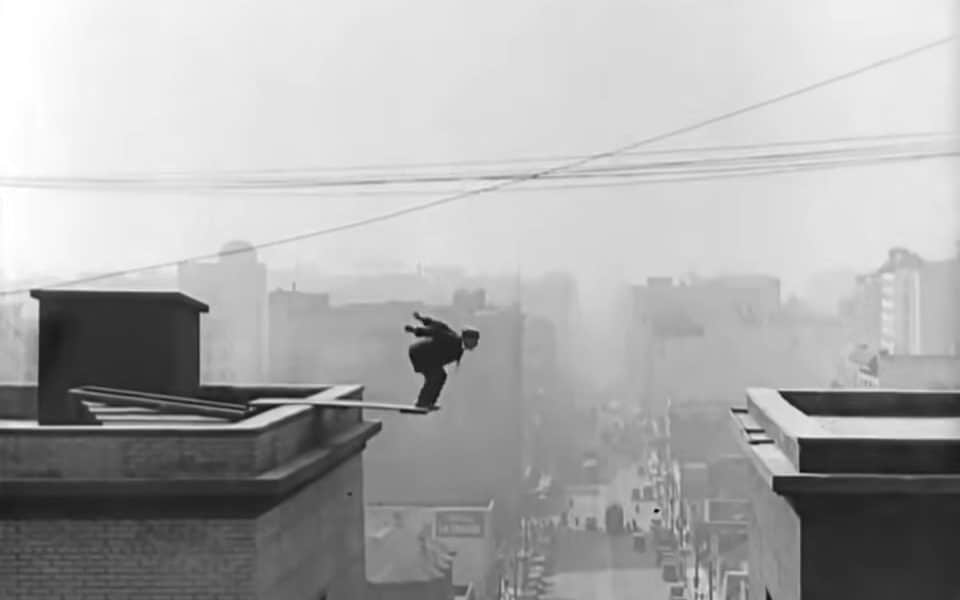
- Oops!Something went wrong.Please try again later.
- Oops!Something went wrong.Please try again later.
- Oops!Something went wrong.Please try again later.
- Oops!Something went wrong.Please try again later.
- Oops!Something went wrong.Please try again later.
- Oops!Something went wrong.Please try again later.
In the late 1990s, Steven Spielberg invited Jackie Chan to his office at DreamWorks to discuss whether the two might one day work together on a film. They were both already mutual fans – and Chan, who described the meeting in his 2015 memoir, began by quizzing the director on the new digital technology that at the time were changing how Hollywood movies were made.
“Oh, it’s simple,” Spielberg shrugged. “I just keep pushing buttons – button, button, button.”
Then the host turned things round, asking Chan how he approached his own eye-popping projects, which the world of visual effects had barely touched. Those, the Hong Kong action star assured him, were even simpler. “It’s ‘rolling’, ‘action’, jump, cut, hospital,” he explained.
Leave it to one of the form’s supreme practitioners to pin down the stunt’s unique appeal in a throwaway line. Cinema usually asks its audience to swallow long, smooth draughts of make-believe, but a stunt is an abrupt, cask-strength shot of reality – something mad, impossible and dangerous that had to actually take place, in some capacity, in order to have made it to our screens.
Of course, they’re never quite as mad, impossible and dangerous as they look. At the UK premiere of The Fall Guy last week, when stunt designer Chris O’Hara was asked if a sense of constant peril made his job more exciting, he looked sheepish before explaining that actually, no-one’s lives were ever at stake, and every possible step was always taken to mitigate risk.
In other words, there is a sensible way to get a speeding car to barrel roll eight and a half times in mid-air, or jump a truck over a 68-metre-wide canyon, or have Ryan Gosling wrestle goons in a skip that’s being dragged through downtown Sydney at speed. It’s just that as you watch it happen, you can’t imagine what that sensible way could possibly be.
O’Hara devised many of The Fall Guy’s stunts to pay homage to some all-time classics of the form. Some of them are among my own top 20, drawn from across exactly 100 years of filmmaking, that show the art and discipline of stunt design at its very best. I’ve ruled out car chases and fight scenes (those deserve lists of their own) and made my selections based purely on the heart-rattling power of the finished shot. Here they are – and how they were pulled off.
20. Motorcycle jump off cliff
Mission: Impossible – Dead Reckoning Part One (2023)
Following his sofa-bouncing antics of 2005, Tom Cruise’s public image was at an all-time low: a cultish crackpot who at any given moment might do something completely unhinged. Ingeniously, over the next few years, he turned that into his personal brand. From its conspiracy thriller beginnings, the Mission: Impossible franchise morphed into a vehicle for death-defying acts, and this climactic set piece from last year’s seventh instalment is one of the best.
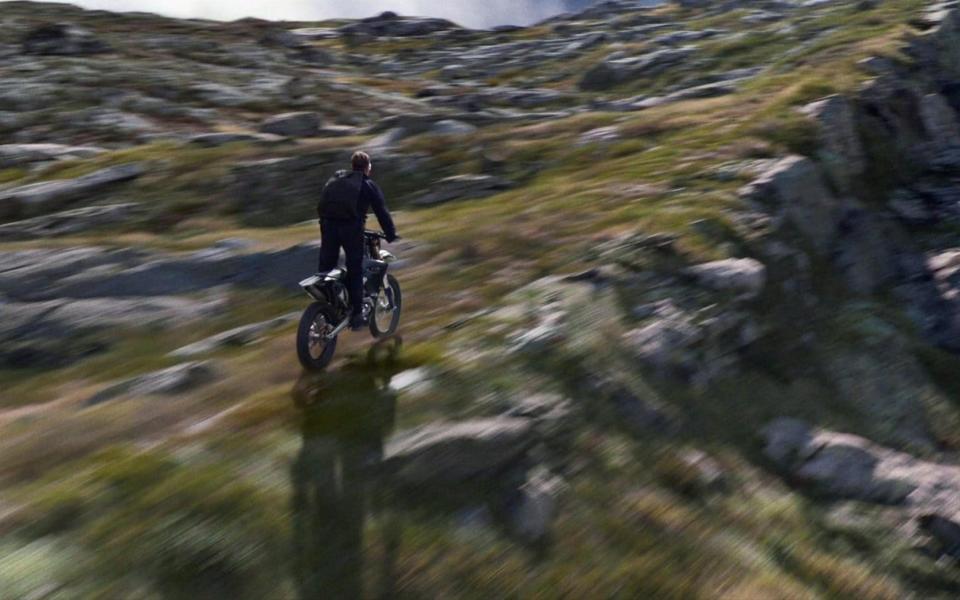
From a wooden ramp (later digitally removed), the star drives a dirt bike off the summit of Norway’s Helsetkopen, then freefalls for six seconds – around 500 feet – before activating his parachute. To prepare, Cruise completed around 13,000 motocross jumps and 500 skydives over the course of a year, then performed the stunt six times on the first day of filming. The moment the camera crests the mountaintop and hangs with Cruise in thin air as the ground drops away delivers an ache of pure amazement that’s virtually unmatched in modern movies.
19. Bridge jump
Smokey and the Bandit (1977)
Automotive acrobatics have been an action comedy staple since the silent days, but there may have never been a jump quite as elegant as this one – pulled off in 1977 by Burt Reynolds’s dashing bootlegger in his Pontiac Trans Am. Swerving off-road to avoid the local sheriff’s men, Reynolds tears down to the half-demolished Mulberry Bridge, floors it, and glides effortlessly across the ravine.
Director and legendary stuntman Hal Needham had his hero’s vehicle fitted with a steam-powered booster rocket, erected a hidden ramp on the higher bank, and added weighting to the car’s boot in order to achieve the absurdly clean and graceful flight arc that makes the scene such a hoot. To ensure the maximum chance of success, Needham himself got behind the wheel, and despite the apparently smooth landing, the car was a write-off – though following the film’s release, Trans Am sales went through the roof.
18. Articulated lorry flip
The Dark Knight (2008)
A TNT-powered piston was the secret behind – or rather, underneath – the centrepiece stunt in Christopher Nolan’s Batman sequel, which takes place at the climax of the Joker’s elaborate jailbreak. Yes, that is a real 18-wheel articulated lorry, and yes, it really does turn end-over-end in the middle of downtown Chicago – though Nolan and his stunt coordinator Paul Jennings ran a test on a deserted airfield first, to ensure the vehicle wouldn’t topple sideways and smash through the wall of a department store or bank.
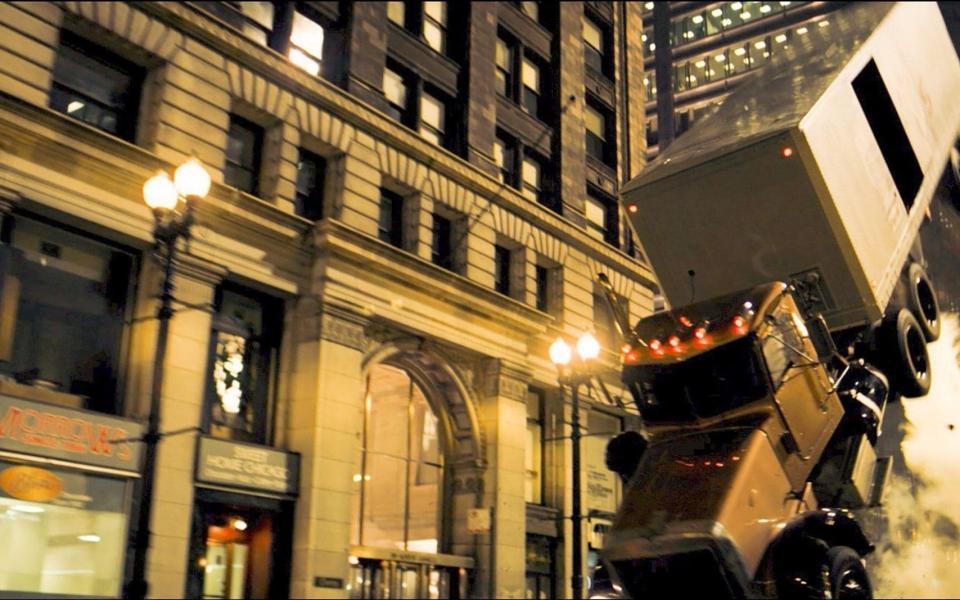
Veteran stunt driver Jim Wilkey was behind the wheel, and triggered the explosion himself at a very particular point in the road, when the piston wouldn’t smash downwards into a sewer, but rather propel the trailer up and over the cab into which he was strapped. Nolan shot the flip from two angles and brilliantly cuts between them right at the tipping point – keeping the audience’s hearts in their mouths just a split second longer, and making the feat feel even more treacherous than it is.
17. Rollerskating on the brink
Modern Times (1936)
Charlie Chaplin seemingly comes close to breaking his neck multiple times during this immortal silent-comedy sequence, in which his Tramp character roller-skates through a deserted department store while blindfolded, trundling perilously near to a wide-open two-story drop.
But the yawning atrium he skirts is in fact just empty floor space, hidden behind a glass matte painting positioned a few feet in front of the camera lens. Both geometry and choreography are immaculate: while you’d swear Chaplin repeatedly swings his leg out into empty space, the angle of the balcony is just steep enough that his body never quite overlaps with the painted-over area, creating an illusion of danger with invisible seams.
16. Limousine helicopter rescue
True Lies (1994)
For peak nineties Hollywood, look no further than the climax of James Cameron’s recently restored action comedy: a limousine, a chopper, a gaggle of jihadis taken down by gorgeous Californians.
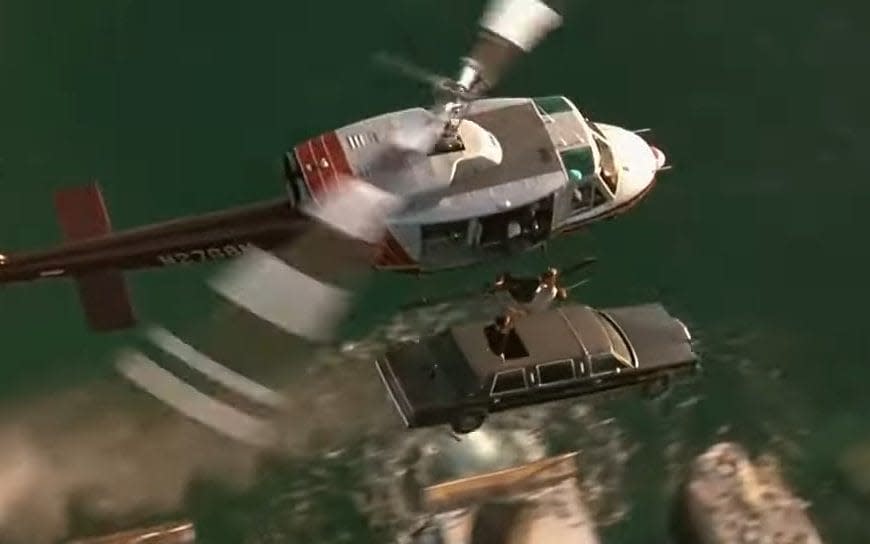
The publicity machine at the time suggested that really was Jamie Lee Curtis being lifted out of the runaway vehicle by Arnold Schwarzenegger in the scene’s final seconds, just as the car rockets off the end of the ruined motorway bridge and plunges into the turquoise waters of the Florida Strait. But while the overhead shot does show Curtis herself dangling from the arm of Schwarzenegger’s stunt double Joel Kramer, the actress’s own double, Donna Keegan, is the one we see being hoisted out at the crucial moment.
15. Window Jump
The Bourne Ultimatum (2007)
When Paul Greengrass took charge on the second Bourne film in the early noughties, the Surrey-born director changed the texture of all modern Hollywood stunt work. Suddenly, invention and spectacle weren’t enough: it had to look grittily plausible, too, as Matt Damon’s Treadstone sleeper agent brought the previously swagger-prone spy genre into the jittery present. (In the early Daniel Craig films, even James Bond himself quickly followed suit.)
Perhaps the single shot that best sums up the Greengrass ethos appears in the Tangier chase scene in the third Bourne film, as Damon (or rather, his stunt double Martin Ivanov) leaps across a series of narrow alleys, window to window, in order to outsmart his pursuers. Just as we’ve acclimatised to the frantic editing and pacing, the sequence briefly drops into slow-motion as a handheld camera follows our hero off the edge of a balcony, through mid-air, and crashing through a shower of glass shards, which – safety first! – was added later in CG.
14. Skyscraper slide
Who Am I? (1998)
This entire top 20 could be nothing but Jackie Chan clips and it would still be a reasonably credible list. The Hong Kong action icon’s first scene appears in this early English-language effort about an amnesiac military operative being chased around the world by CIA turncoats. Its showpiece moment occurs in Rotterdam, where Chan battles his way to the top of the city’s Willemswerf office block through squads of pistol-toting goons.
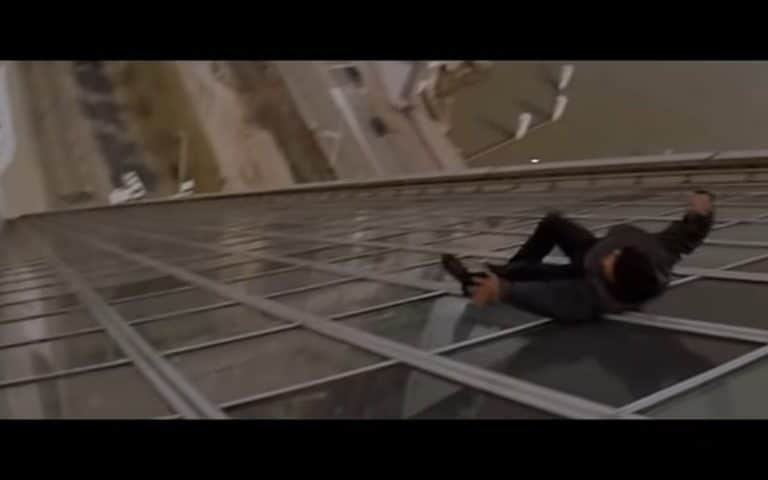
When he reaches the roof, only one escape route remains open: a 21-story slide down its ever-narrowing diagonal glass roof. Chan slid down the building in its entirety multiple times to obtain enough tumbles and spins for the scene’s slapstick escalation, all without the aid of a safety harness, though walked – or perhaps limped – away with nothing more than an ankle injury to show for it.
13. Ship’s sail knife slide
The Black Pirate (1926)
It might not be the most daring stunt here, but it’s certainly one of the more iconic, having been recreated, spoofed and homaged countless times in the last 98 years. In the title role, the great silent-era swashbuckler Douglas Fairbanks is in the process of single-handedly capturing a ship. With a cannon serving as counterweight, he uses a pulley to soar up to the top of the mast with a foe tucked under one arm, then stabs his dagger into the topsail and slides down again, rending his enemies’ emblem in two in the process.
The move was co-designed by Fairbanks’ brother Robert, and involved a second pulley and counterweight, fastened to the actor’s knife and concealed behind the sail itself, which had been pre-torn then loosely stitched back together in order to achieve a clean cut. The angle of descent – around 45 degrees – allowed Fairbanks to descend smoothly under his bodyweight alone, though the camera was similarly tilted to make the descent look vertiginous.
12. The rotating hallway
Inception (2010)
Christopher Nolan has often borrowed tricks and techniques from vintage cinema, and it’s testimony to the ingenuity of filmmakers working at the time that the results still look this good. In 1951’s Royal Wedding, for instance, Fred Astaire danced up the walls and along the ceiling – a trick that still astonishes now – but was made possible by nothing more complex than a set which spun on its axis like a hamster wheel, and a camera that moved with it, keeping the ‘floor’ at the bottom of the frame no matter which way was up.
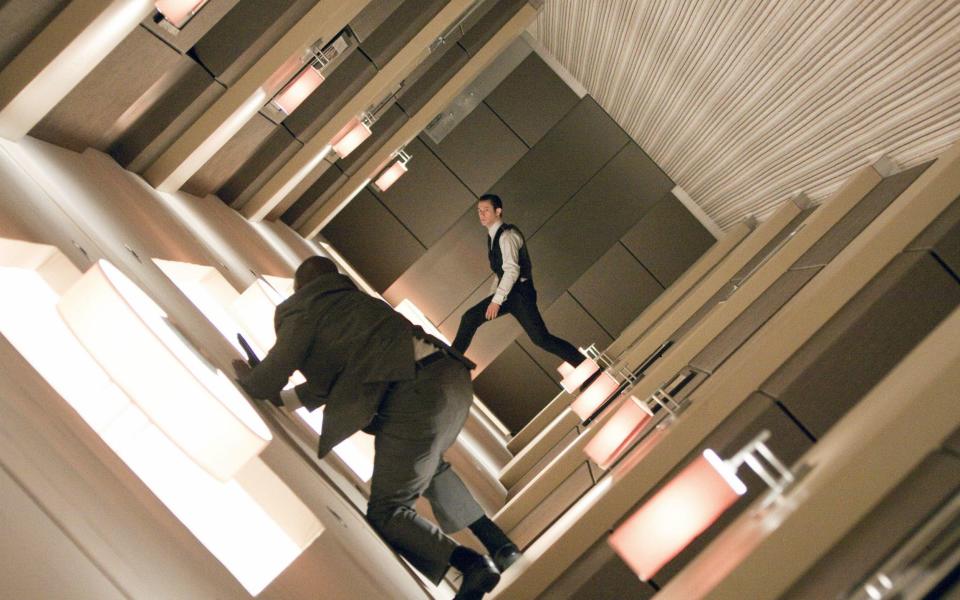
For a similar sequence in Inception – replace dancing with fighting – Nolan had two hotel hallways, each 100 feet long, built inside an airship hangar: one which hung vertically, and another which sat horizontally, but could be rotated like a centrifuge. The first was used for the antigravity shots, captured on a camera mounted on a vertical arm that could stretch up into the space; the second was for the stomach-lurching gravitational shifts, and contained both a camera on a crane arm and another mounted on hidden rails in the carpet.
Switching from one to the other allowed Nolan to toy with the audience’s perceptions: first, it feels as if the room is spinning, but then as our viewpoint anchors itself to what looks like the ground, the actors’ movements become hard to rationally process. Editor Lee Smith would later explain that the corridor section of the fight unfolds mostly in a single take because the sheer visual impossibility of the scene meant it took viewers a few seconds to work out exactly what they were looking at.
11. Falling from the roof
Three Ages (1923)
It’s not often that when a stunt goes wrong it ends up even better than planned. But that was what transpired on the set of Buster Keaton’s first self-directed feature – a spoof of DW Griffith’s history-straddling epic Intolerance, with sections set in prehistoric, Roman and modern times. In the third of these, Keaton tries to jump from the roof of one tall Los Angeles building to the next. He creates an impromptu springboard from the hinged wooden hatch on a trapdoor, springs forward across the gap…and his fingers only graze the opposite ledge.
On set, Keaton fell into a safety net just out of shot, and while he recovered from the fall, filming had to be paused for three days. He loved the footage, though, so created a second stunt that could be grafted onto the first: he would drop through three awnings, then grab a drainpipe which bent through 180 degrees, catapulting him through the window of a fire station, across the dormitory floor and down the pole hole, bringing him back to ground level with a bump.
This famous failed stunt has been replicated a number of times – not least by Jackie Chan, who worked a tribute version into his 1983 thriller Project A that also paid homage to a certain other silent cinema moment further down the list. Clinging to the hands of a clock, his grip loosens and he falls through two canvas shades before landing flat on the ground. Chan thought his first attempt didn’t look dangerous enough, so he did it again, landed nastily on his head, and severely injured his neck. Which take did he end up using? Both, run back to back.
10. The collapsing house
Steamboat Bill, Jr. (1928)
Here’s another classic from Keaton’s nerve-mangling oeuvre, taken from his last picture at United Artists. A hurricane blows into town, and Keaton’s paddle steamer captain is deposited by the wind in front of a wobbling house, whose entire facade falls forward on top of him, only for his body to pass through a tiny attic window, sparing his life by inches.
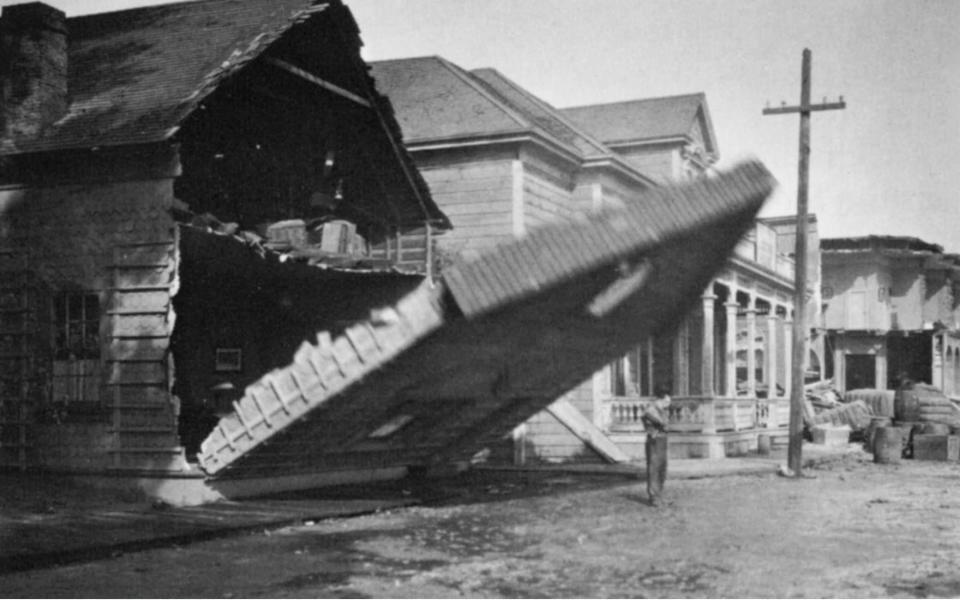
The wall itself weighed two tons – it had to look plausibly heavy on camera for the stunt to work – and the safe spot where Keaton had to stand in order to avoid being hit was a single nail the set designers hammered into the ground. Legend has it that for the crucial take, Keaton’s shoes were nailed in place too – and that various crew members, including the camera operator, looked away at the pivotal moment. Perhaps it became his most famous stunt because it’s a perfect expression of his Old Stone Face persona: the unthinkably daring thing he’s doing is standing still.
“I was mad at the time, or I would never have done the thing,” Keaton later admitted, though described the scene as “one of my greatest thrills”.
9. Clutching the clock
Safety Last! (1923)
This Harold Lloyd scene could be the entire silent comedy era distilled: a hapless young man trapped in an outrageous fix that’s not entirely of his own making, while modern life thrums away heedlessly beneath. In the film, Lloyd isn’t even supposed to be climbing the 12-story Bolton building in downtown Los Angeles – he’s a stand-in for a pal who’s meant to be doing it as a publicity stunt. But after beginning the ascent himself, just to get the show underway, our hero’s numerous attempts to switch out with the expert are thwarted – so up and up he scrambles.
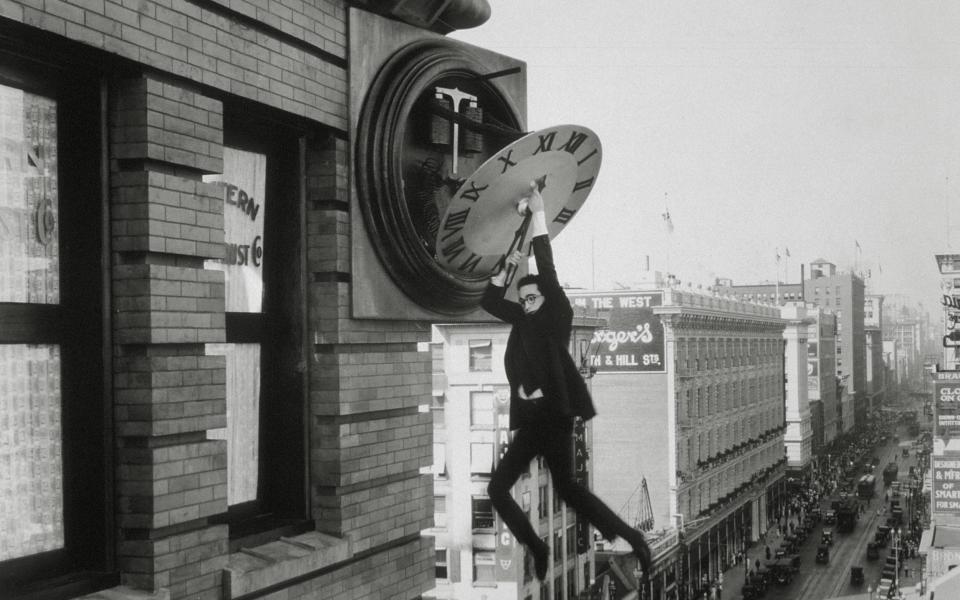
Lloyd was fearsomely protective of the secrets behind his work, so no photographs exist to show exactly how these hair-raising shots were obtained. But it’s thought the side of the tower he’s seen clinging to was a series of vertical sets built on the roofs of various shorter buildings in the neighbourhood, so that cameras mounted on wooden towers could capture both Lloyd and the drop to the street in the same frame without revealing the star wasn’t quite hanging directly above it. The early wide shots of the climb show daredevil Bill Strother, who also plays Lloyd’s fearless friend Limpy Bill, and whose prior feats in Los Angeles had inspired Lloyd to create the sequence in the first place.
8. Evading Stuntman Mike
Death Proof (2007)
In his (under-appreciated, says this critic) fourth feature, Quentin Tarantino bottles everything he loves about the 60s and 70s chase movies that made practical car-based stunts an art form – then carbonates it, shakes it up, and twists the lid. Each half of the film ends with a showpiece practical set-piece: the first being a grisly demonstration by Kurt Russell’s Stuntman Mike of his “death-proof” Chevy Nova, during which he murders five young women in an 80mph thrill-kill crash. But the second eclipses it, along with arguably everything else the genre produced. Stuntwoman Zoë Bell, playing herself, is engaging in a game of ‘Ship’s Mast’ – riding on the bonnet of her friends’ 1971 Dodge Challenger while holding onto two belts looped around its door frames.
This is nerve-wracking enough when it’s going well – but then up pops Mike again, who repeatedly slams his Dodge Charger into Bell’s vehicle at speeds of up to 100 miles per hour, as she clings on for dear life. (Russell’s driving double was Buddy Joe Hooker, a veteran of the 70s stunt scene.) The sequence, pulled off without a pixel of visual effects, took six weeks to capture – and the sense of danger is sky-high throughout, as Bell slides around helplessly on the bonnet, her body constantly swinging within inches of the tarmac hurtling past underneath.
7. The Pole Cat attack
Mad Max: Fury Road (2015)
“I don’t understand two things,” Steven Soderbergh once memorably said of George Miller’s blistering petrolhead opus. “I don’t understand how they’re not still shooting that film, and I don’t understand how hundreds of people aren’t dead.” Many viewers will feel likewise during the sequence in which the Gas Town armada lays siege to Max and Furiosa’s War Rig, which suddenly finds itself surrounded by desert buggies with ominous masts protruding from their backs. Each one of these is gripped by a team of Pole Cats – buccaneers who sway perilously from side to side, until they manage to swing low enough to board our heroes’ truck.
Shot at a distance, the sight of these lunatics swooping against the Namibian desert has an eerie grace and magnificence. But up close, it’s like a Cirque de Soleil performance choreographed by Satan, as some of these masked fiends swing chainsaws and pickaxes at Max and co while others pluck hostages from their seats.
6. Shopping centre atrium drop
Police Story (1985)
Disaster! During a skirmish in a Hong Kong shopping centre, a briefcase of vital evidence has fallen into the bad guys’ clutches, and ace cop Chan Ka-kui (Jackie Chan) is six floors above it. Escalators aren’t an option: instead, in a single take, Ka-Kui leaps over the balcony’s guard rail and out into the middle of the atrium, grabbing a pole and sliding down through an exploding web of decorative lights. And all that lay below to break his fall was a glass-topped booth.
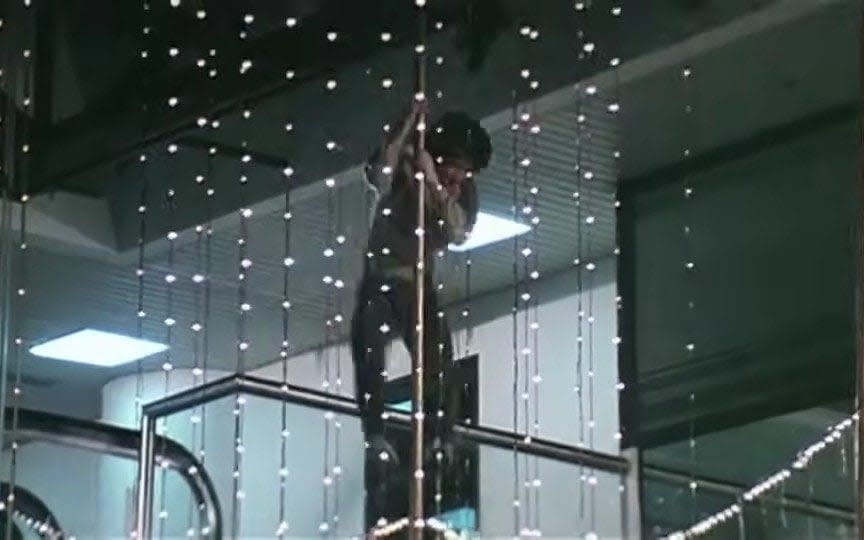
This was one of the final shots captured of Police Story’s climactic 15-minute mall showdown, and there was only time available for a single take. The angle and duration of the shot meant no safety harnesses or crash mats could be involved: Chan really did jump out into empty space; if he’d misjudged that initial eight-foot leap, who knows if he would have survived. The fall is shown three times in a row from different angles, but you can’t begrudge Chan wanting to show it off: he sustained second-degree burns on the palms of his hands during the slide, injured his back and dislocated his pelvis in the landing. Nevertheless, he instantly springs to his feet afterwards and keeps fighting.
5. Dragged beneath horses
Stagecoach (1939)
Many of the stunts in this list have been riffed on over the years, but this must be the most influential of the lot. An Apache raider, played by the former rodeo rider Yakima Canutt, pulls level with the Tonto-to-Lordsburg stage as it clatters through Monument Valley at top speed. He then leaps directly from his steed onto the vehicle’s front two horses, straddles both – then takes a bullet from John Wayne’s Ringo Kid, falls between the animals and clings to their harness. After being dragged for a few seconds across the sand, he loses his grip, seemingly gets trampled underhoof, and is left writhing in agony on the ground.
Canutt pulled it off by urging the driver to run the horses as fast as he could: more speed meant a longer, narrower gait, which created a tiny safe zone between the animals that he could tuck himself into, if he clasped his arms tight across his chest. The resulting shot almost single-handedly made Canutt’s name as the most accomplished stuntman alive, and has been copied countless times – not least in The Fall Guy, though it’s a speeding flatbed truck and a skip loader Ryan Gosling jumps between in that case. Its best-known modern iteration appears in Raiders of the Lost Ark: stuntman Terry Leonard met with Canutt beforehand to obtain his blessing – and some potentially life-saving tips.
4. The chariot race
Ben-Hur (1959)
Two decades after Stagecoach, Yakima Canutt was still the man to go to for horse-based action, and he ended up co-directing the most celebrated sequence in this now more-talked-about-than-watched 1950s Biblical epic, in which Charlton Heston’s former galley slave becomes a champion charioteer.
It was a suitably monumental undertaking, with the planning alone spanning almost a year: horses were specially trained, chariots were built, and a vast arena constructed in a quarry by Rome’s Cinecittà Studios, before being filled with 40,000 tons of sand shipped in from the Mediterranean coast. Filming itself took three months, though the foundering postwar economy in Italy made it a gruelling stop-start business, with a riot breaking out one morning among 3,000 would-be extras who turned up to set only to discover that the day’s background roles had already been filled.
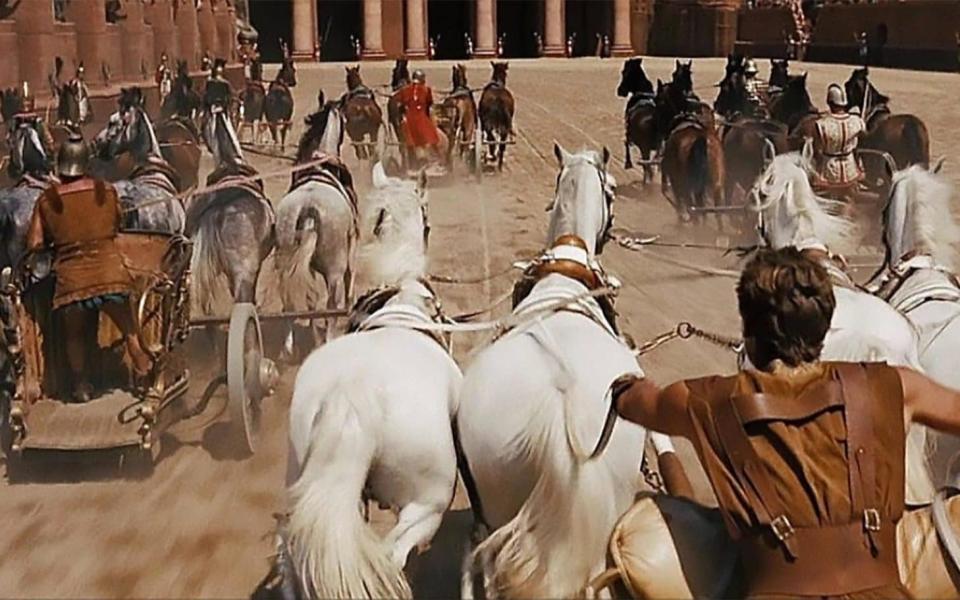
In all but the close-ups the riders are played by stuntmen: Heston’s double was Canutt’s son Joe, who at one point is thrown forward over the front of his chariot, and only manages to stay in the race by grabbing onto his horses’ harnesses. (Like father, like son.) The footage of this accident, which resulted in nothing worse than a four-stitch cut to Canutt Jr’s chin, was used in the film, perhaps fuelling the (false) urban legend that a stunt double had died on set, and his demise was visible in the final cut. The rumour mill wasn’t exactly stymied by a disastrous press conference at which Canutt’s co-director on the sequence, Andrew Marton, lost patience with the media’s macabre line of questioning, and sarcastically claimed that 20 actors and 100 horses had perished during the shoot.
3. Motorcycle train jump
Police Story 3: Supercop (1992)
No less an authority than Tarantino (see above) once claimed this thriller from the heyday of Golden Harvest studios contained the greatest stunts ever staged – and viewed as a package, it may be the single most impressive title here. Jackie Chan and Michelle Yeoh star as two supernaturally nimble law enforcers, who variously jump from speeding cars and cling to the sides of getaway vans in their efforts to bring down a drug lord.
The friendly rivalry between the two performers pushed both to attempt increasingly outrageous feats, with Yeoh initially insisting that the climactic dangle from a helicopter flying through Kuala Lumpur should be hers. In the end, Chan pulled rank and nabbed the scene for himself, though director Stanley Tong’s peace offering to his leading lady upstaged it: a motorcycle jump onto a moving train. Yeoh learned to ride especially for the sequence, and during filming overshot the train twice, bouncing off the roof before hurtling into a pile of cardboard boxes – the Hong Kong industry’s crash mat of choice – on the far side of the track.
2. Burj Khalifa climb
Mission: Impossible – Ghost Protocol (2011)
For all the Imax-stretching grandeur of this extraordinary sequence – one of the most iconic in the 21st century blockbuster canon – it’s essentially just Safety Last! cranked up to an absurd degree, and owes as much to its perfectly judged comic rhythm as its life-or-death showmanship. In place of a downtown Los Angeles tower is the world’s tallest skyscraper, and in place of Harold Lloyd it’s Tom Cruise’s Ethan Hunt, who must scale the outside of the building, from the 123rd to 130th floor, with the use of hi-tech suction gloves.
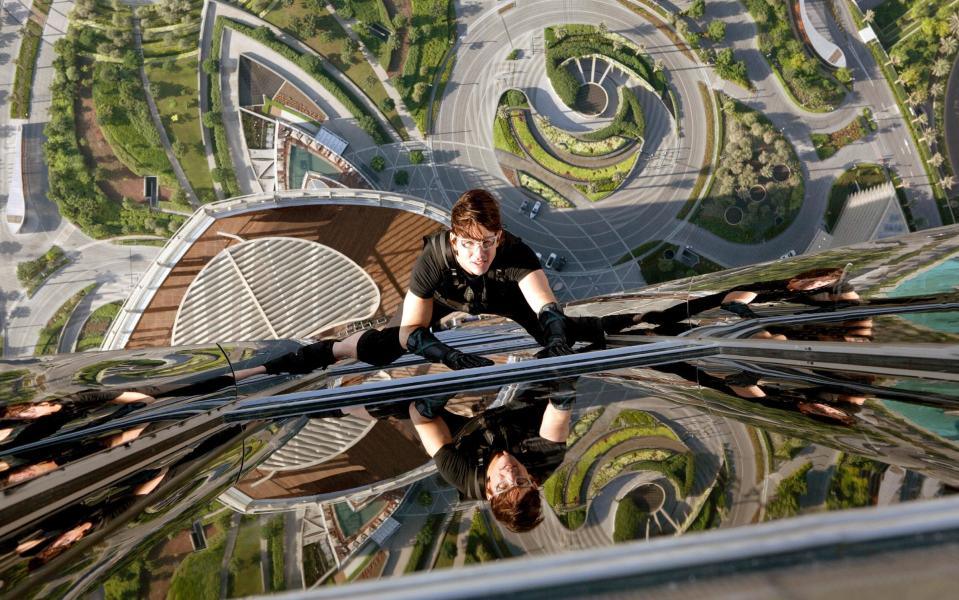
The touch of pure genius is that one of the gloves malfunctions almost immediately, adding an almost cartoonish level of peril to the feat. Cruise performed it himself, understandably with a safety harness that was later airbrushed out. The final flourish – Cruise plummets from a 130th floor window on a cable, makes a sidelong dash along the wall of the building to safety, then almost messes up his final leap by a matter of inches – is one of those joyous cinematic moments where you can feel an entire audience’s stomachs collectively drop through the floor in perfect sync.
1. The handlebar ride
Sherlock Jr. (1924)
There are two groups of people reading this list. Those who can’t believe a 100-year-old stunt can possibly still be the best ever conceived and performed, and those who have seen it. It begins at top speed, with Buster Keaton’s private detective haring down the street, in pursuit of the gang who kidnapped his dame. His sidekick Gillette pulls level on his motorbike, bundles Keaton onto the handlebars, and off they screech together, though when a pothole deposits Gillette on the tarmac, the bike roars on regardless.
Tearing through criss-crossing traffic, it takes Keaton a good few miles to realise no-one is driving, by which point he’s somehow swerved around corners, through a stag party’s tug-of-war, across a river, and – in an extraordinarily clever piece of trick photography – across an unfinished bridge, the gap in which is plugged for a split second by two passing trucks. Then comes the insane coup de grâce: a sidelong shot of Keaton on an apparent collision course with a steam train, which he misses by a hair’s breadth, only to miss a car by an even smaller margin seconds after that.
This moment was ingeniously captured backwards, with both car and train reversing down the road and track respectively, allowing Keaton to rip past them a split second after, rather than before, they block his route. It concludes, naturally, with a punchline, as the now thoroughly puzzled Keaton turns around to presumably ask Gillette what on earth he’s up to. And with the shock realisation he isn’t there, for the first time, the driverless bike finally wobbles.
Sherlock Jr is screening with a live score at London’s Prince Charles Cinema at 12.30pm on Sunday May 5. Tickets: princecharlescinema.com

